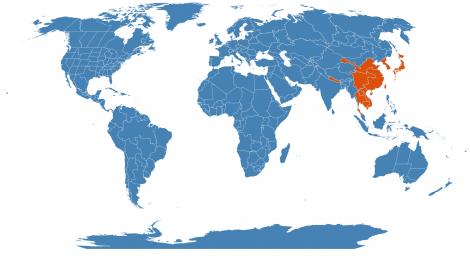Accession Data:
Boehmeria nivea (L.) Gaudich.
- Common Name: Chinese Silk Plant
- Family: Urticaceae Juss.
- Description: Coarse, hispid-stemmed perennials, 3-5 feet high or more; leaves alternate, broadly ovate, to 6 inches long or more, acuminate, cuneate or rounded at base, white-tomentose underneath; panicles densly branched, mostly shorter than subtending petiole.
- Uses: One of the oldest fiber plants in cultivation, Ramie has been used for over 6,000 years and has even been identified in mummy cloths dating from 5,000 BC.3
The extraction of the fibre occurs in three stages. First the cortex or bark is removed; this can be done by hand or by machine. This process is called de-cortication. Second the cortex is scraped to remove most of the outer bark, the parenchyma in the bast layer and some of the gums and pectins. Finally the residual cortex material is washed, dried, and de-gummed to extract the spinnable fibre.4
- IMPORTANT NOTE: Plant Uses are for informational purposes only. EEB Greenhouses assume no responsibility for adverse effects from the use of any plants referred to on this site. Always seek advice from a professional before using any plant medicinally.
- USDA Zone: 7b-11
Accession Data:
- Accession # 198500370
- Source: G. Anderson
- Accession Date: 12-31-1985
- Bench: 3310 - NEOB: StarSteel 3x12
- Currently: active - healthy
- Qty: 2 confirmed on 06-18-2025
Classification:
- Division: Magnoliophyta
- Class: Magnoliopsida
- SubClass: eurosid I
- Order: Rosales
- SubOrder:
- Family: Urticaceae
- SubFamily:
- Tribe: Boehmerieae
- SubTribe:
Flowering Data:
This accession has been observed in bloom on:| Year | Jan | Feb | Mar | Apr | May | Jun | Jul | Aug | Sep | Oct | Nov | Dec | ||||||||||||||||||||||||||||||||||||||||
|---|---|---|---|---|---|---|---|---|---|---|---|---|---|---|---|---|---|---|---|---|---|---|---|---|---|---|---|---|---|---|---|---|---|---|---|---|---|---|---|---|---|---|---|---|---|---|---|---|---|---|---|---|
| 2025 | ||||||||||||||||||||||||||||||||||||||||||||||||||||
| 2024 | ||||||||||||||||||||||||||||||||||||||||||||||||||||
| 2023 | ||||||||||||||||||||||||||||||||||||||||||||||||||||
| 2022 | ||||||||||||||||||||||||||||||||||||||||||||||||||||
| 2021 | ||||||||||||||||||||||||||||||||||||||||||||||||||||
| 2020 | ||||||||||||||||||||||||||||||||||||||||||||||||||||
| 2019 | ||||||||||||||||||||||||||||||||||||||||||||||||||||
| 2018 | ||||||||||||||||||||||||||||||||||||||||||||||||||||
| 2017 | ||||||||||||||||||||||||||||||||||||||||||||||||||||
| 2016 | ||||||||||||||||||||||||||||||||||||||||||||||||||||
| 2015 | ||||||||||||||||||||||||||||||||||||||||||||||||||||
| 2014 | ||||||||||||||||||||||||||||||||||||||||||||||||||||
| 2013 | ||||||||||||||||||||||||||||||||||||||||||||||||||||
| 2012 | ||||||||||||||||||||||||||||||||||||||||||||||||||||
| 2011 | ||||||||||||||||||||||||||||||||||||||||||||||||||||
| 2010 | ||||||||||||||||||||||||||||||||||||||||||||||||||||
| 2009 | ||||||||||||||||||||||||||||||||||||||||||||||||||||
| 2008 | ||||||||||||||||||||||||||||||||||||||||||||||||||||
| 2007 | ||||||||||||||||||||||||||||||||||||||||||||||||||||
| 2006 | ||||||||||||||||||||||||||||||||||||||||||||||||||||
| 2005 | ||||||||||||||||||||||||||||||||||||||||||||||||||||
| 2004 | ||||||||||||||||||||||||||||||||||||||||||||||||||||
| 2003 | ||||||||||||||||||||||||||||||||||||||||||||||||||||
References (internal):
- Wind Pollination (anemophily)
- Fiber Plants
- EEB 3271 - Systematic Botany
- EEB 3203 - Developmental Plant Morphology
- Medicinal Plants - Traditional African Medicine
- Scavenger Hunt - Grades 9-12 (generic)
- EEB Greenhouse Holdings native to: China South-Central / Hainan / China North-Central / China Southeast / Japan / Korea / Taiwan / Nepal / Cambodia / Laos / Thailand / Vietnam
References (external):
- Boehmeria nivea at Plants For A Future. Accessed 2 June 2015.
- Hortus Third, LH Bailey Hortorium, 1976
- Ramie at Wikipedia. Accessed 2 June 2015.
- Swicofil
- USDA Plants Database
- The Plant List (2013). Version 1.1. Accessed 2 June 2015.
- Boehmeria nivea at Flora of China. Last accessed on Tuesday, July 26, 2016.
- Image #00 (cropped) & #01 (original) by Daderot (Own work) [Public domain], via Wikimedia Commons
- Image #02 (original) by Xue Davis (Own work). Used with permission. Last accessed on Wednesday, October 10, 2018.
data regenerated on Tue, 24 Jun 2025 14:09:05 -0400 [bcm v4.0]
Images:

Additional images for this accession:
Click on thumbnails to enlargeCurrent Accessions in the Urticaceae
Subfamily
Tribe Boehmerieae
Subfamily
Tribe Cecropieae
Subfamily
Tribe Lecantheae
- Pellionia repens


- Pilea cadierei


- Pilea depressa


- Pilea nummulariifolia

- Pilea peperomioides


- Procris unidentified
Subfamily
Tribe Parietarieae
Subfamily
Tribe Urticeae
W/C = Wild Collected
 = indicates flowering in past 14 days
= indicates flowering in past 14 days
 = images available for this accession
= images available for this accession
 = map available for this accession
= map available for this accession
 = accession added within past 90 days
= accession added within past 90 days


